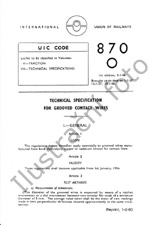Potřebujeme váš souhlas k využití jednotlivých dat, aby se vám mimo jiné mohly ukazovat informace týkající se vašich zájmů. Souhlas udělíte kliknutím na tlačítko „OK“.

UIC B126/RP43-1ed.
Braking Questions - Synthesis paper on the EuropeTrain operation with LL brake blocks - Final Report
Přeložit název
NORMA vydána dne 1.2.2013
Informace o normě:
Označení normy: UIC B126/RP43-1ed.
Datum vydání normy: 1.2.2013
Kód zboží: NS-1190229
Počet stran: 206
Přibližná hmotnost: 649 g (1.43 liber)
Země: Mezinárodní technická norma
Kategorie: Technické normy UIC
Anotace textu normy UIC B126/RP43-1ed. :
The whole procedure concerning the development of the LL- block is described in report B 126/RP 36, issued in 2009. Even though all requirements as defined in UIC Leaflet 541-4 have been fulfilled sufficiently, a final homologation of the System LL blocks was not possible due to some still open questions. However, it was decided to extend the preliminary homologation to large scale in-service tests. Based on this homologation the project EuropeTrain was designed as a train running in commercial service representing different vehicle types and brake equipment.
The friction material selected for the equipment of the EuropeTrain (C952-1 and IB116*) was subject to the full test procedure according to Leaflet 541-4 (4th edition, December 2010).
Both products sufficiently fulfilled all safety requirements as requested in the Leaflet and would have been able to start ordinary large-scale service tests in different applications under the condition that the equivalent conicity of the wheel sets would have to be determined after an initial 50,000 km and then every 25,000 km as specified in the "Usage guidelines for composite (LL) brake blocks".
Especially this requirement causes enormous additional logistics in the operation, bears the risk of unsafe operation (if not considered carefully) and adds an unacceptable supplementary financial burden to the operators. So UIC launched the EuropeTrain project with three major objectives:
Validating some solutions to prevent the fast degradation of equivalent conicity (e.g. the effect of new shape or position of brake blocks) and giving more insight into the mechanism of the system interactions between wheel, brake block and rail.
Verification of vehicle stability by continuous in-service measurement and track tests. Assessment of the equivalent conicity generated by LL-blocks in comparison with cast iron brake blocks, allowing the definition of currently non-existing in-service limit values (if necessary at all) and thus a new evaluation of LCC.
Verification that LL blocks are capable of bearing all climatic, operational and topographical conditions in Europe under affordable LCC.
To get more insight into the correlation between equivalent conicity and running behaviour, selected vehicles are equipped with accelerometers and a data logger system to determine any increases in acceleration or unstable running behaviour during operation. Wagons with increased equivalent conicity are subject to specific dynamic tests on standardised track in accordance with UIC Leaflet 518 to determine whether this increase is still acceptable considering the running behaviour of the vehicle.
As a result of more than 200.000 km of successful operation throughout Europe and several special running tests according to UIC Leaflet 518, this report shows a very clear comparison of the development of equivalent conicity over the mileage between the different block materials, provides a deeper understanding of the correlation between equivalent conicity and running behaviour and provides a huge data base for LCC analyses.
"+
"
Name:Fragen des Bremswesens - Synthese des EuropeTrain-Betriebs mit LL-Bremssohlen - Schlussbericht|
Das Verfahren zur Entwicklung der LL-Sohlen ist im Bericht B 126/RP 36 aus 2009 beschrieben. Auch wenn alle Anforderungen aus UIC-Merkblatt Nr. 541-4 hinreichend erfüllt wurden, konnte keine endgültige Zulassung des LL-Bremssohlensystems erfolgen, da einige Fragen offen blieben. Allerdings wurde die vorläufige Zulassung auf eine breit angelegte Betriebserprobung erweitert. Aufbauend darauf wurde das Projekt EuropeTrain konzipiert, in dessen Rahmen verschiedene Wagenbauarten mit unterschiedlichen Bremsausrüstungen im Betrieb getestet werden sollten.
Die für den EuropeTrain ausgewählten Reibmaterialien (C952-1 und IB116*) durchliefen das komplette Versuchsverfahren nach UIC-Merkblatt Nr. 541-4 (4. Ausgabe, Dezember 2010).
Beide Produkte erfüllten alle sicherheitstechnischen Anforderungen aus dem genannten Merkblatt und hätten im Rahmen einer normalen Betriebserprobung in verschiedenen Anwendungen eingesetzt werden können, insofern die äquivalente Konizität der Radsätze nach den ersten 50.000km und danach alle 25.000 km bestimmt wird, so wie in der "Anwendungsrichtlinie V-BKS (LL)" [2] spezifiziert.
Insbesondere diese Anforderung erfordert eine Vielzahl logistischer Vorkehrungen und birgt, wenn nicht sorgfältig behandelt, ein betriebliches Sicherheitsrisiko. Ferner zieht sie nicht zuletzt einen inakzeptablen finanziellen Aufwand für die Betreiber nach sich. Daher initiierte die UIC das Projekt EuropeTrain, das sich drei Hauptziele setzte:
Validierung von Lösungen zur Vermeidung einer schnellen Verschlechterung der äquivalenten Konizität (z.B. Auswirkung neuer Sohlenform oder -position) und Erkenntnisse über die Mechanismen des Zusammenwirkens Rad - Bremssohle - Schiene.
Überprüfung der Fahrzeugstabilität im Rahmen kontinuierlicher Messungen im Betrieb und von Streckenversuchen. Beurteilung der durch die LL-Sohlen verursachte äquivalente Konizität im Vergleich zu Grauguss zwecks Bestimmung neuer, derzeit im Betrieb (oder überhaupt) nicht üblicher Grenzwerte und davon ausgehend Ermittlung der LCC.
Sicherstellung, dass die LL-Sohlen unter allen klimatischen, betrieblichen und topographischen Bedingungen in Europa unter zumutbaren LCC eingesetzt werden kann.
Um einen tieferen Einblick in die Korrelation zwischen der äquivalenten Konizität und dem Laufverhalten zu gewinnen, wurden ausgewählte Fahrzeuge mit Beschleunigungsmessern und Datenloggersysteme ausgerüstet, um erhöhte Beschleunigungen oder instabiles Fahrverhalten im Betrieb aufzuzeichnen. Güterwagen mit erhöhter äquivalenter Konizität wurden gemäß UIC-Merkblatt Nr. 518 speziellen Fahrversuchen auf einem standardisierten Gleis unterzogen, um zu prüfen, ob die höheren Werte unter Berücksichtigung des Fahrzeugverhaltens noch als akz
Odebírejte informace o nově vydaných normách ZDARMA:
Chcete pravidelně odebírat informace o nově vycházejících normách z celého světa a to zcela zdarma?
Přihlašte se k odběru. Vše je velice jednoduché a absolutně ZDARMA.
Na výběr máte vydavatele z celého světa.



 Cookies
Cookies
